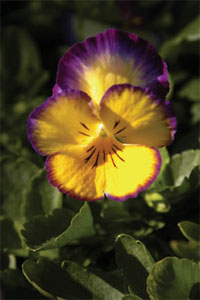Gardening Beyond the Season:
 Cultivate beauty during the coolest times of the year
Cultivate beauty during the coolest times of the year
We are lucky to live in a mild climate where we can continue to garden the entire year. There are many kinds of plants to choose from to extend color and interest in the yard through winter. Without snow to add visual interest, we should choose plants with colorful and textural leaves, berries, interesting bark and flowers.
Pansies and violas, with their cheerful flower faces, are commonly used for annual winter color. Each year plant breeders introduce more and more single and bicolor blooms to choose from. Planted in October or early November, they will flower in all but the severest cold and bring you about six months of color until time for a summer color change.
Use cool-season herbs and vegetables to introduce much-needed texture and height to a winter flowerbed. Leaf celery (Apium graveolens), curled parsley (Petroselinum crispum) and salad burnet (Poterium sanguisorba) are evergreen in the cold and lend different shades of green to your beds while also providing you with fresh herbs for salads and other delicious recipes.
Add structure with herbs like rosemary ‘Hill Hardy’ (Rosemarinus officinalis), sage (Salvia officinalis) and thyme (Thymus sp.), all of which can be cut and used in the kitchen all year long. These herbs are especially nice to have planted for use during the holidays.
Ornamental cabbage and kale have been planted for years, but edible kale (Brassica oleracea) grows to 2 feet in height and is a much larger specimen. The bold leaves can be frilly or smooth with a tinge of purple, red or white. ‘Redbor,’ ‘Winterbor’ and ‘Lacinata’ kale are three very sturdy varieties to plant.
Swiss chard (Beta vulgaris) is now available with red, pink, yellow or orange ribs and veins in the leaves and is beautiful until late spring.
Shrubs provide permanent plantings and will make the transition into winter gracefully. The leaves of heavenly bamboo (Nandina domestica), turn various shades of red in the winter months. Many varieties also put on a flush of red berries just in time for holiday decorating. These plants are available in a wide range of mature heights.
Winter honeysuckle (Lonicera fragrantissima) is a freestanding shrub with fragrant white flowers in winter and early spring. It grows 8 to 10 feet tall and is in bloom at a time when little else is happening in the garden.
Virginia sweetspire’s (Itea virginica) leaves turn a brilliant burgundy and then persist on the plants well into winter, then finally drop to the ground. It has a graceful growth habit, as well, and named varieties range in height from 2 to 6 feet tall.
Don’t forget the beauty of a holly (Ilex) bush, with its multitudes of bright red berries. Choose from many like ‘Burford,’ ‘Needlepoint,’ possumhaw, and weeping yaupon. For an orange-red fruit choose ‘Nellie R. Stevens.’
Not only is it much more pleasant to be outside when it is cool but having flowers, foliage and berries to enjoy make it all the more interesting.
About the author: Sharon Lee Smith is co-owner of Blue Moon Gardens, a retail nursery and garden center in Chandler (www.bluemoongardens.com).
For more about gardening in winter, see the November/December issue of Neil Sperry’s GARDENS Magazine. Click here to subscribe.

